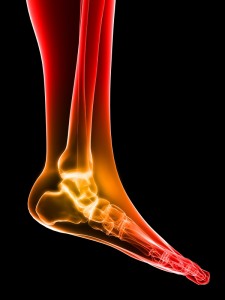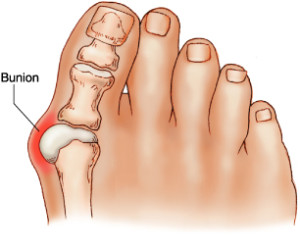 When it comes to living a functional and happy life with diabetes, effective foot care is vital. Podiatrists are acutely aware of the unique needs of diabetics and the foot and ankle orthopedic specialists at AOSMI are ready, able, and eager to ease the discomforts of living with diabetes.
When it comes to living a functional and happy life with diabetes, effective foot care is vital. Podiatrists are acutely aware of the unique needs of diabetics and the foot and ankle orthopedic specialists at AOSMI are ready, able, and eager to ease the discomforts of living with diabetes.
Studies have shown that, with or without diabetes, nearly 80 percent of Americans have trouble with their feet. It’s no wonder since our feet and ankles are the part of the body that is under the most amount of stress on a daily basis. We rely on our feet to take us from point A to point B without problems, and often in a hurry. In sports, the feet and ankles are often the first body part to suffer injuries and since they are so crucial to our everyday existence it takes these body parts longer to heal.
The specialists at AOSMI are trained to recognize, diagnose, and treat foot and ankle injuries in the most conservative manner possible. We will do all we can to get you back to new without invasive surgery. In the event surgical measures are needed, our New Jersey orthopedic surgeons will provide exceptional care that will get you back on your feet in no time.
Call us today for a consultation and put your foot health in the hands of experts.
 At the simplest level, bunions are a deformed growth in a bone at the base of the big toe. Aside from being visually unattractive, bunions can make it almost unbearable to wear shoes, walk any real distance or carry on with your usual activities. As summer approaches us, many are looking down and feeling the pain. Perhaps you are in this situation and have finally reached a place of readiness to call an orthopedic specialist. New Jersey orthopedic surgeons treat bunions every day and are on top of the latest treatments, surgical or otherwise.
At the simplest level, bunions are a deformed growth in a bone at the base of the big toe. Aside from being visually unattractive, bunions can make it almost unbearable to wear shoes, walk any real distance or carry on with your usual activities. As summer approaches us, many are looking down and feeling the pain. Perhaps you are in this situation and have finally reached a place of readiness to call an orthopedic specialist. New Jersey orthopedic surgeons treat bunions every day and are on top of the latest treatments, surgical or otherwise.
When it comes to recovering from surgery for bunions, physical therapy is your ticket to mobility. We found this excellent video that shows just one of the many ways that stretching can help with bunion surgery recovery. Watch and learn. Practice before surgery to be prepared!
Can You Benefit from Cartilage Replacement Surgery?
Chances are you probably won’t give much thought to the protective cartilage that cushions your bones until it wears down to the point that it becomes raw and painful. Each year, thousands of people must undergo surgery to repair torn cartilage because the pain interferes with their daily lives. Repair usually means shaving damaged cartilage, but many younger, more active patients are excellent candidates for cartilage replacement surgery. This exciting therapy aims to eliminate pain, restore function and reduce or delay the need for total joint arthroplasty. So, what exactly is cartilage, and how can it be damaged and repaired?
What is cartilage?
Cartilage is a rubbery, smooth substance found in every joint in your body. It serves to help bones glide smoothly within a joint and as shock absorption.
How can cartilage be damaged?
Your cartilage can be damaged through trauma such as twisting or direct impact; ligament injuries that make your joint unstable or loose resulting in damage to the joint surface cartilage; and poorly aligned joints placing excess pressure on cartilage. The damage can be painful, as well as limit everyday activities like walking.
What are your options for treatment?
While cartilage can be damaged in the hip, ankle, shoulder and elbow, the most common area of injury is the knee. Cartilage replacement in knee injuries is an excellent alternative to total knee replacement and especially promising for more active patients. Some of the treatment options involved in cartilage replacement surgery include:
- Arthroscopic and open cartilage replacement procedures
- Performed through small incisions, these are used to stimulate cartilage restoration, replace areas of damaged cartilage with healthy cartilage from elsewhere in the knee, replace damaged cartilage with donor cartilage and bone, or encourage knee cartilage regeneration using your own cartilage cells.
- Limited (partial) replacement of joint surfaces
Used instead of total joint replacement for older active patients
- Realignment procedures
Called osteotomies, this can be done to take pressure off of damaged and repaired areas of the joint.
Who can be treated?
Anyone from teens to middle-aged adults can be treated with the techniques that orthopedic surgeons use to repair or regenerate cartilage. The surgery can be performed at an outpatient surgery center or a hospital, depending on the procedure.
What happens after you’ve had treatment?
After you have cartilage replacement surgery in a joint, you must return to activity gradually. It will take time and patience, so don’t expect to return to the activities you enjoyed before your injury occurred. The treatment after surgery often requires specialized physical therapy, under the direct supervision of physicians.
If you’ve been suffering joint pain and are interested in treatment options beyond total replacement surgery, cartilage replacement surgery may be for you. An orthopedic surgery practice dedicated to the repair and restoration of cartilage, like the Cartilage Restoration Center in New Jersey, a division of Advanced Orthopedics and Sports Medicine Institute, can help. With Board-certified surgeons utilizing the latest techniques, you’ll be well on your way to returning to that active lifestyle you’ve been missing.
 With winter upon us, many people participate in activities such as snow skiing, snowboarding, and ice skating. The very conditions that make these activities possible and enjoyable, reduced friction, also make falls and injuries very common. Winter sports injuries get a lot of attention at hospital emergency rooms and doctor’s offices, and include sprains, strains, dislocations and fractures (broken bones). READ MORE.
With winter upon us, many people participate in activities such as snow skiing, snowboarding, and ice skating. The very conditions that make these activities possible and enjoyable, reduced friction, also make falls and injuries very common. Winter sports injuries get a lot of attention at hospital emergency rooms and doctor’s offices, and include sprains, strains, dislocations and fractures (broken bones). READ MORE.







